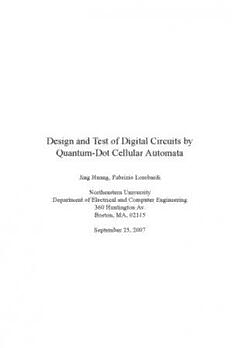Table Of ContentDesign and Test of Digital Circuits by
Quantum-Dot Cellular Automata
JingHuang, FabrizioLombardi
NortheasternUniversity
Department ofElectrical and ComputerEngineering
360HuntingtonAv.
Boston,MA, 02115
September25,2007
Contents
Preface xiii
Chapter1 Introduction 1
1.1 Challenges 2
1.2 PreviousWork 3
1.3 Contributions 4
1.4 BookOutline 7
References 8
Chapter2 NanoDevicesandArchitecturesOverview 11
2.1 NanoelectronicDevices 12
2.1.1 CarbonNanotube-basedDevices 12
2.1.2 Nanowires 14
2.1.3 MolecularElectronicDevices 15
2.1.4 Single-ElectronDevices 17
2.1.5 ResonantTunnelingDiodes 21
2.1.6 SpinTransistors 22
2.2 Nano-scaleCrossbars 23
2.3 Architectures 25
2.3.1 SETArchitecture 26
2.3.2 RTDArchitecture 26
2.3.3 NanoFabricsArchitecture 27
2.3.4 NanoPLA 29
References 33
vii
viii Contents
Chapter3 QCA 37
3.1 QCAImplementation 42
3.1.1 MetalQCA 42
3.1.2 MolecularQCA 44
3.1.3 MagneticQCA 45
3.2 Clocking 46
3.3 MolecularAttachment 49
3.4 PowerGainandDissipation 51
3.5 QCASimulators 53
3.5.1 QCADesigner 54
3.6 QCACircuits 56
3.7 ComparisonofNanotechnologyDevices 61
References 64
Chapter4 QCACombinationalLogicDesign 69
4.1 Gate-basedCombinationalLogicDesign 69
4.1.1 Gate-basedDesignofQCAwithExistingCommer-
cialSynthesisTools 71
4.2 LogicSynthesis 73
4.2.1 AND/OR-basedLogicSynthesis 73
4.2.2 Muroga’sMV-basedLogicSynthesis 75
4.2.3 MAjorityLogicSynthesizer(MALS) 75
4.3 StructuralDesign 75
4.4 AND-OR-Inverter(AOI)Gate 76
4.4.1 AOIGateCharacterization 76
4.4.2 DefectCharacterizationoftheAOIGate 78
4.4.3 LogicSynthesisUsingtheAOIGate 82
4.4.4 Conclusion 87
References 89
Chapter5 Logic-LevelTestingandDefectCharacterization 91
5.1 Logic-LevelTesting 91
5.1.1 Stuck-atTestPropertiesofMV-basedCircuits 92
5.1.2 TestSetforMVs 95
5.1.3 C-TestabilityofMV-basedDesigns 96
5.2 DefectCharacterizationofDevices 99
5.2.1 SimulationEngines 101
5.2.2 MVDefectAnalysis 102
5.2.3 InterconnectDefectAnalysis 107
Contents ix
5.2.4 ProbabilisticAnalysisandTesting 111
5.2.5 DefectAnalysisandTestingofQCACircuits 116
5.2.6 ScalinginthePresenceofDefects 133
5.2.7 Conclusion 140
References 141
Chapter6 Two-DimensionalSchemesforClocking/TimingofQCACircuits 143
6.1 ClockingAnalysis 144
6.2 Two-DimensionalQCAClocking 146
6.3 Two-DimensionalWaveQCAClocking 151
6.4 ExamplesofQCACircuits 156
6.5 FeedbackPaths 159
6.6 SimulationResults 160
6.6.1 2-to-1Multiplexer 161
6.6.2 One-bitFullAdder 161
6.6.3 RSFlip-flop 161
6.7 Conclusion 162
References 168
Chapter7 Tile-BasedQCADesign 171
7.1 QCADesignbyTiling 174
7.2 FullyPopulatedGridAnalysis 176
7.3 TilesBasedon3 3Grids 179
×
7.3.1 OrthogonalTile 179
7.3.2 DoubleFan-outTile 183
7.3.3 BaselineTile 187
7.3.4 Fan-inTile 190
7.3.5 TripleFan-outTile 192
7.4 AnalysisofResults 195
7.4.1 ConfigurationSelection 196
7.5 LogicAnalysis 196
7.6 ExamplesofQCACircuits 200
7.6.1 One-bitFullAdder 200
7.6.2 ParityChecker 201
7.6.3 2-to-4Decoder 206
7.6.4 2-to-1MUX 208
7.7 Conclusion 210
References 211
x Contents
Chapter8 SequentialCircuitDesigninQCA 213
8.1 RSFlip-flopandDFlip-flopinQCA 214
8.1.1 DefectCharacterizationofRSFlip-flop 216
8.2 TimingConstraintsinQCASequentialDesign 219
8.2.1 TimingConstraintsUsingRSFlip-flops 220
8.2.2 TimingConstraintsusingDFlip-flops 221
8.3 AlgorithmforClockingZoneAssignment 221
8.3.1 AlgorithmOutline 221
8.3.2 AlgorithmDetail 223
8.3.3 AlgorithmforCoplanarDevice 226
8.3.4 ExamplesofQCACircuits 227
8.4 DefectCharacterizationofQCASequentialCircuits 229
8.5 DiscussionandConclusion 239
References 246
Chapter9 QCAMemory 247
9.1 Introduction 247
9.2 ReviewofQCAMemories 249
9.3 ParallelMemoryArchitecture 252
9.3.1 ProposedParallelQCAMemoryDesign 252
9.3.2 ClockingConsiderations 255
9.3.3 DiscussionandComparison 257
9.3.4 Simulations 261
9.4 SerialMemoryArchitecture 263
9.4.1 MemoryDesignbyTiling 263
9.4.2 ClockingandTiming 266
9.4.3 QCATiles 268
9.4.4 Simulation 271
9.4.5 Conclusion 285
References 285
Chapter10ImplementingUniversalLogicinQCA 287
10.1 UniversalGate 288
10.2 UniversalGateDesigns 289
10.2.1 AND/OR-basedSynthesis 290
10.2.2 MV-basedSynthesis 290
10.3 Memory-basedLUT 294
10.4 Multiplexer-basedLUT 298
10.5 DiscussionandConclusion 301
Contents xi
References 302
Chapter11QCAModelforComputingandEnergyAnalysis 305
11.1 ReviewonReversibleComputing 306
11.2 MechanicalModel 308
11.2.1 ModelofQCACell 309
11.2.2 SteadyStateEnergyofQCADevices 312
11.3 EntropyandDissipationAnalysis 315
11.3.1 OperationoftheMechanicalCell 315
11.4 LandauerandBennettClockingSchemes 320
11.5 Conclusion 323
References 325
Chapter12FaultToleranceofReversibleQCACircuits 327
12.1 HardwareRedundancyTechniques 328
12.2 MajorityMultiplexinginQCA 333
12.2.1 FaultTolerantCapacity 334
12.2.2 RestorationSpeedofMultiplexing 336
12.2.3 Summary 338
12.3 ReversibleComputingandFaultTolerance 339
12.4 EnergyDissipationofaReversibleMVMultiplexingSystem 341
12.4.1 SystemWithoutFault 341
12.4.2 DissipationinFaultCorrection 342
12.5 Conclusion 344
References 347
Chapter13ConclusionandFutureWork 349
App.A PreliminaryforQCAMechanicalModel 353
References 356
App.B ValidationofMechanicalModel 357
B.1 ValidationofStaticEnergyAnalysis 357
B.2 ValidationofDissipationAnalysis 358
References 360
App.C EnergyDissipationAnalysisofCircuitUnits 363
AbouttheAuthors 367
xii Contents
Preface
Emergingtechnologieshavebeen a topic ofgreatinterestoverthe last few years;
aspredictedbytheTechnologyRoadmapoftheSemiconductorIndustry,CMOSas
today’s dominanttechnologyfor manufacturingcomputersystems by Very Large
Scale Integration (VLSI) will be encountering serious hurdles in the future. The
projected expectations in terms of device density, power dissipation and perfor-
mancenecessitateradicallydifferenttechnologiesthatprovideinnovativesolutions
to integration as well as computing. So-called emerging technologies have been
advocatedfromdisparatesources(bothindustryandacademia)tomeetthese am-
bitiousobjectives,whilerealizingtheever-higherdemandsposedbytheubiquitous
natureofcomputinginmodernsociety.
This book addresses one of the most interesting among emergingtechnolo-
giesfor digitaldesign,Quantum-dotCellular Automata(QCA). Overthe last few
decadessinceitsinceptionattheUniversityofNotreDame,QCAhasdramatically
evolvedinadynamicandexcitingfieldofinvestigationwithcontributorsfromall
overthe world. QCA is a challengingtechnologythat due to its uniquestructural
andoperationalfeaturesrepresentsarevolutionarydeparturefromcurrentpractice.
QCA relies on principlesthat are fundamentallydifferentfrom CMOS and there-
fore,it mayofferunprecedentedadvantagesto solve those challengesthatare ex-
pectedtooccurattheendofthetechnologyroadmap.Forexample,asitsoperation
isbasedonCoulombicinteractions,designersofQCA-basedcircuitsmustbemade
awareoftheimplicationsthatselectiveproperties(suchasthosebasedonswitching
and clocking) may come into play once a QCA circuit is embedded on a planar
layout.
Numerous journal and conference articles have appeared in the technical
literature; the last few years have also seen an increased number of professional
meetingsinwhichmanysessionshavebeendevotedtoadvancesinQCA.However,
QCA necessitates an understandingof physicaland electrical phenomenathat are
notreadily available from a single source. This book providea focused reference
by which up-to-date topics are treated in detail with direct impact on research
xiii
xiv DesignandTestofDigitalCircuitsbyQuantum-DotCellularAutomata
and practical implementations; moreover, its contents reflect an interdisciplinary
approach by which scientists and engineers can mutually benefit. Only essential
mathematics and physics are presented, while devoting substantial coverage to
design and manufacturing issues as well as related topics such as testing, defect
modelingandperformance.
In this book, we have combined topics that cover the whole spectrum of
interests in QCA: starting from a basic characterization at device-level, circuits
andmodulardigitalsystems(suchasmemoriesanduniversallogic)areintroduced
to the reader within a systematic and intuitive presentation that include examples
as well as comparison metrics. The organization is structured such that starting
withanintroductiontoemergingtechnologies,up-to-datefundamentalsofQCAare
reportedtoengagethereaderintothemostrecentadvancesofthisfieldasreflected
inthe detailedtreatmentofsequentialandcombinationalQCA circuits. Themain
emphasisis,however,ondesignandtesttoincludedigitalQCAcircuitsandmodels
forcharacterizingamongthemanyattributespowerconsumption,defectdiagnosis,
modularity and fault tolerance. QCA can encompass multiple desirable features
within different technological frameworks (based on metal as well as molecular
implementations) and new computational paradigms (such as processing-by-wire
andstorage-by-motion).
The material covered in the chapters requires a basic understanding of
physics, mathematics and electrical/electronic engineering, as commonly made
availableinanundergraduatedegreeprogram.Thisbookcanthereforebeusedasa
referenceaswellastextbookforseniorelectiveandgraduatecoursesinnanotech-
nology,withanemphasisonemergingtechnologies.Advancedresearcherswillalso
find this book interesting as it provides a detailed treatment of QCA and issues
involvedin integratingbasic devicefunctionalities(combinationalandsequential)
intoworkingcircuitsandsystems.NovelresearchdirectionsinQCAarealsopro-
videdfortheinterestedtechnicalinvestigator.Theauthorsofeachchapterhavean
in-depthknowledgeofQCAasreflectedintheirstudiesandworkexperience;this
bookistheresultoftheauthors’researchanddevelopmentinQCAovermorethan
fiveyearsassupportedbyfederalagenciesandindustrialpartners.
This book has been made possible by the collaborationof all authors;also,
the authors would like to acknowledge enlightening discussions with Craig Lent
(UniversityofNotreDame),DougTougaw(ValparaisoUniversity),KonradWalus
(University of British Columbia), Cecilia Metra (University of Bologna), Salva-
tore Pontarelli (University of Rome Tor Vergata), Marya Libermann (University
of Notre Dame), Niraj Jha (Princeton University), Hamid Hashempour, Sanjukta
Bhanja(UniversityofSouthFlorida)andJoseFortes(UniversityofFlorida).Their

